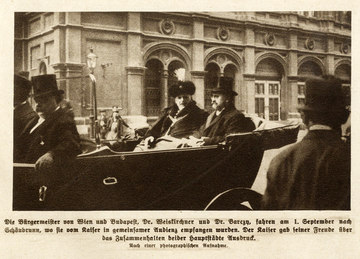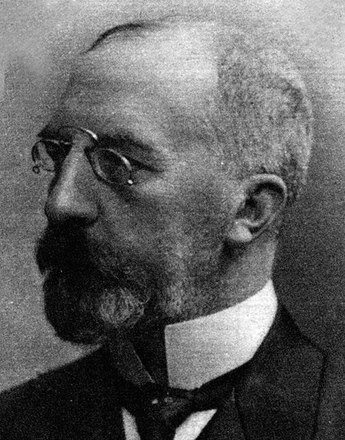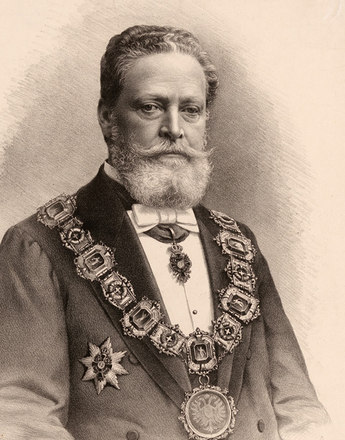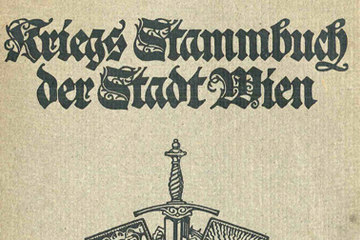
The Mayor of Vienna Richard Weiskirchner and the Mayor of Budapest, Istvan Barczy, on the way to Schönbrunn for the ceremony of homage to the Emperor, photo from Wiener Bilder, issue of 5 September 1915
Copyright: Wienbibliothek im Rathaus
Partner: Wienbibliothek im Rathaus – Vienna Library in the City Hall
The Christian-Social mayor appointed in the four-curial electoral system was noted as a pragmatic politician. For a long time he believed he could guide the great new awakening, but in fact had to administer to decline and collapse.
When he was elected as Mayor of Vienna in January 1913, Richard Weiskirchner was known as a tried and tested connoisseur of Austrian politics and administration. From 1897 to 1911 he was a member of the Austrian Parliament, between 1898 and 1915 practised formally as a member of the Lower Austrian Provincial Diet, and from 1909 to 1911 he was Austrian Minister of Trade. From 1903 to 1910 he worked as director of the municipal authorities under Mayor Karl Lueger. Weiskirchner came from the latter’s particular school of city corporation politics and as wartime mayor endeavoured to project the image of a pragmatically acting Christian Social politician with a strong German-national bent. He retained the office of Mayor of the Imperial and Residence Capital until May 1919.
In his political actions and initiatives Weiskirchner presented himself as a prudent, energetic city father, who identified with all the needs of the citizenry entrusted to him. He organised material support for soldiers’ families left at home, protected them against the hardship of eviction, ensured food provisioning with personal interventions, made plots of land available for growing vegetables; he did not shy from taking steps against the upcoming rise in prices and he mediated between the different social groups. The director of the municipal authorities – the Magistratsdirektor – appraised him as a man of indefatigable action, of restless striving and self-sacrifice in fulfilling his duties. At the beginning of the war he was quite successful in dealing with these wide-ranging tasks and intervened in thousands of cases.
In his own self-appraisal he was the right man in the right job and saw a glorious place reserved for him in the history of the city, a role which became more and more ill-fated as the war wore on, because now the mayor who wished to project such a popular image was becoming stylised as the master of disaster. No other monarchist politician floundered in so many abusive letters, suspicions and reproaches of incapability as he was. At the very instant when the first hunger revolts spread throughout the city districts – May 1916 – he was awarded the freedom of the city. In common parlance Weiskirchner was called Mayor Maiskirchner (“Maize-kirchner”) who served up poor, low-calorie bread made of cornflour (Maismehl).
Until the death of Emperor Franz Joseph in November 1916, Weiskirchner informally filled the vacant position of master of ceremonies in the Habsburg Imperial and Residence Capital. The emperor, almost 84 years old at the time of the war manifesto (“An meine Völker!” – “To my Peoples!”) on 28 July 1914, was too weary and weakened to acknowledge ovations, demonstrations and jubilee celebrations in the appropriate form, and to manipulate them with rhetoric. The emperor’s absence continued on the Government level. Prime Minister Count Karl von Stürgkh was hardly ever seen at public festivals and celebrations. The sole minister who made an occasional showing was the Minister for War Alexander Freiherr von Krobatin. The Viennese mayor slipped into this official gap. At the beginning of the war and its first year, he constantly exploited the grand Rathausplatz and the flagged Town Hall to celebrate victories on the front with great patriotic marches and appropriate rhetoric. Weiskirchner joined the “Kriegsbittprozessionen” – supplication processions – led by Cardinal Piffl, when the votive picture of the “Madonna with the Inclined Head” was also borne across the Rathausplatz and God’s blessing was petitioned for victory.
Translation: Abigail Prohaska
Mertens, Christian: Richard Weiskirchner (1861-1926). Der unbekannte Wiener Bürgermeister, Wien 2006
Pfoser, Alfred: Wohin der Krieg führt. Eine Chronologie des Zusammenbruchs, in: Pfoser, Alfred/Weigl, Andreas (Hrsg.): Im Epizentrum des Zusammenbruchs. Wien im Ersten Weltkrieg, Wien 2013, 580-686
-
Chapters
- Wartime Mayor Richard Weiskirchner
- The political system: The “Obmänner”conference and the municipal council
- Yet again capital of the Monarchy: a larger population, more tasks, more bureaucracy, fewer resources
- “Approvisionierung”
- State, communal and voluntary welfare
- Tenancy protection
- “The Dying City”








